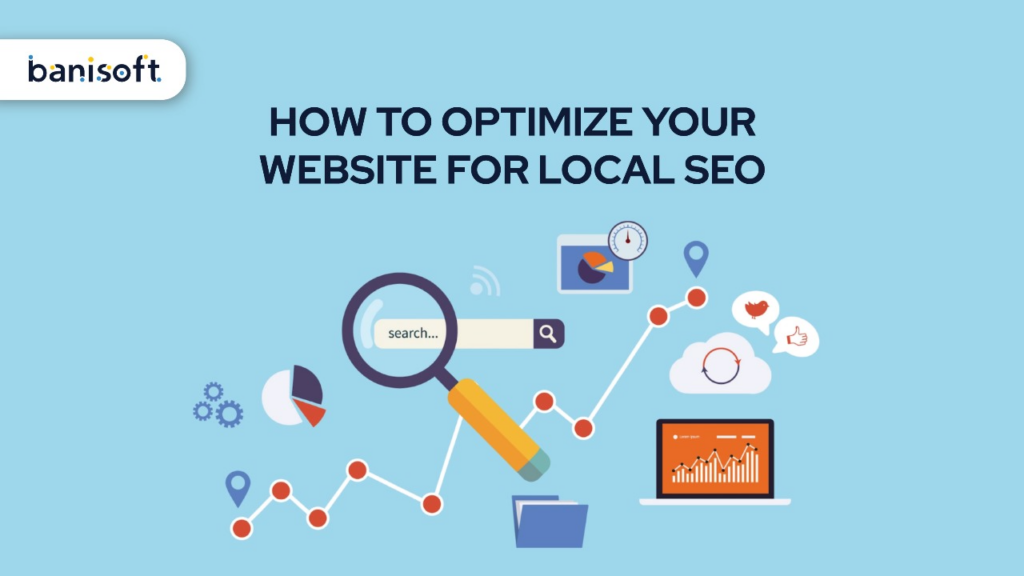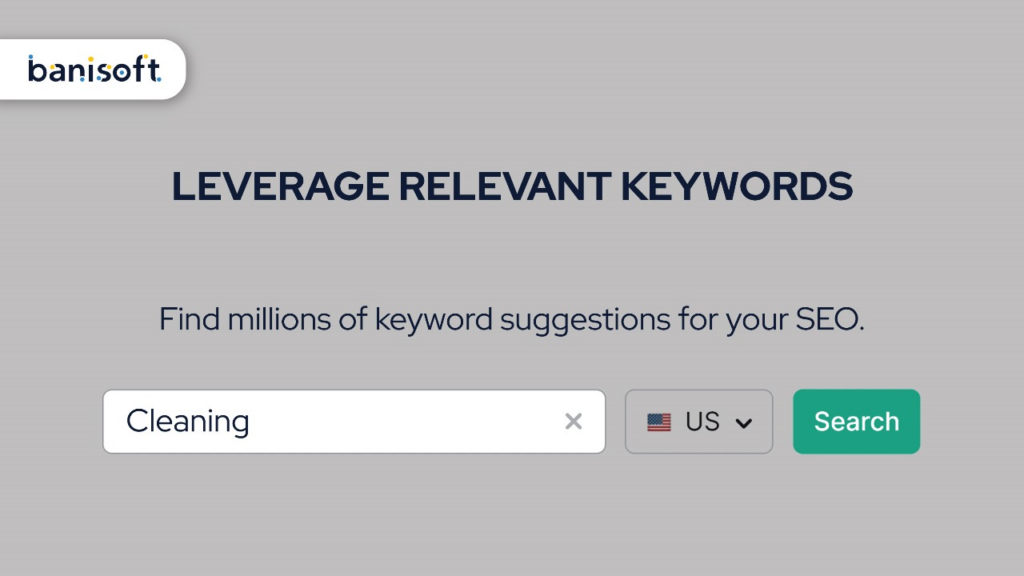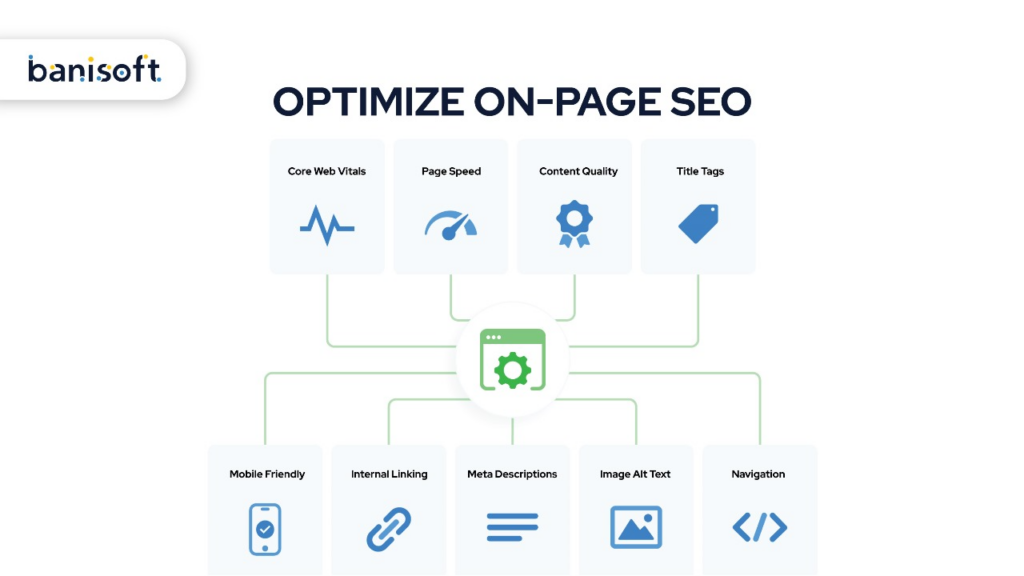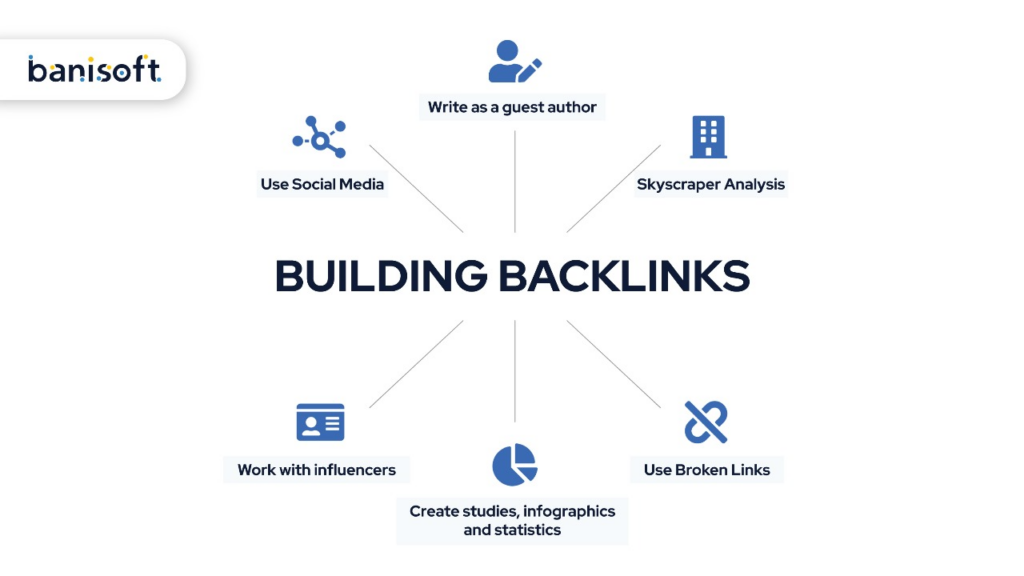Top SEO Strategies to Boost Your Dog Training Business

In this digital age, having a strong online presence is essential for any business, including dog training services, to attract new leads and clients.
Dog training classes usually consist of sessions that teach dogs basic manners and how to respond to various commands.
For those who own a dog training business, employing SEO (Search Engine Optimization) techniques is vital for increasing local visibility. SEO services can help your website climb the ranks on search engines, bringing more visitors to your site.
By understanding what search engines like Google prioritize, you can design a user-friendly website with relevant keywords, making sure it appears in key search results.
This blog will explore the importance of SEO and provide actionable tips to boost your online visibility.
Understanding SEO

SEO, or Search Engine Optimization, involves enhancing your website to achieve higher rankings on search engine results pages (SERPs).
The higher your site ranks, the more visible it is to potential clients.
SEO encompasses various techniques and strategies aimed at aligning your content with user searches, thereby increasing organic (non-paid) traffic to your site.
Benefits of SEO for Dog Trainers
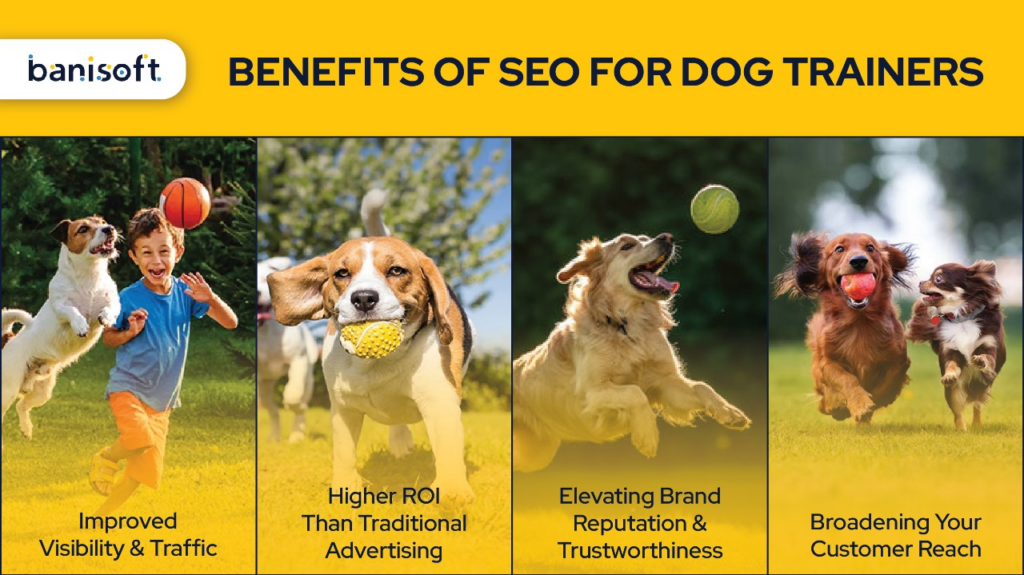
Improved Visibility and Traffic
One of the major advantages of SEO for dog trainers is the increased organic visibility, which leads to more website traffic. SEO is highly targeted and customer-oriented.
An effective SEO strategy ensures that your web pages reach a relevant audience through pertinent search queries.
Since users are actively searching for what you offer, organic visibility attracts high-quality traffic to your site without needing to entice visitors.
Websites that rank at the top of Google’s organic search results capture 33% of the traffic, with the second spot not far behind. If your site isn’t on the first page, you’re likely missing out on potential clients.
Higher ROI Than Traditional Advertising
When assessing digital marketing channels, return on investment (ROI) is a crucial factor.
Although SEO results take time to materialize, a well-executed strategy can eventually deliver a significant ROI.
Search engine leads have a close rate of 14.6%, nearly 12% higher than traditional marketing methods. Conversely, if your website is buried on page two, three, four, or beyond, your leads will be virtually non-existent.
The top organic listing on Google attracts 39.8% of all search traffic.
Compared to traditional advertising, SEO offers a higher ROI, as effective SEO strategies attract targeted traffic that is more likely to convert into leads and clients.
Elevating Brand Reputation and Trustworthiness
Achieving a top spot on search engine results pages (SERPs) lends your website an air of trust and credibility.
Investing in SEO not only boosts your rankings but also enhances your brand’s reputation, making it more likely that potential clients will trust your services.
But why is this important? It signals to potential customers that you’re a dependable source worth considering for their needs.
Picture this: you’re planning to launch a new website to sell dog products but don’t know where to start. You search “How to build a website for selling dog products” on Google.
One of the top results is a detailed guide from a leading website in the industry, which significantly boosts its credibility.
The more frequently you appear in search results, the more benefits you gain from SEO, such as building trust, credibility, and brand recognition.
Broadening Your Customer Reach
SEO isn’t just for businesses with a single target audience. It’s equally effective for companies targeting multiple demographics with the same service.
A well-optimized website ensures your business shows up in relevant search results, increasing awareness of your services and expanding your customer base.
Key SEO Strategies for Dog Training Businesses

Keyword Research
Identifying the right keywords is crucial for a successful SEO strategy in dog training services.
The best keywords are those commonly used by your target audience when searching for dog training information and services.
The aim is to find keywords that are not only relevant but also have high search volume and low competition.
Tools like Google’s Keyword Planner and SEMrush are invaluable for discovering niche-specific terms that potential clients might use.
These tools provide insights into search volumes and suggest related keywords. Examples include “dog trainer near me,” “puppy training classes,” and “dog behaviorist.”
On-Page SEO
On-page SEO involves optimizing individual web pages to rank higher and attract more relevant traffic. Focus on:
- Meta Tags: Incorporate your target keywords in title tags, meta descriptions, and header tags (H1, H2, H3).
- Content: Create high-quality, informative content that addresses common questions and solves problems for your audience.
- Images: Optimize images with descriptive file names and alt text that includes your keywords.
- Internal Linking: Link to other relevant pages on your website to enhance navigation and keep visitors engaged.
Off-Page SEO
Off-page SEO involves strategies executed outside your website to enhance its ranking. Key tactics include:
- Backlinks: Secure top-notch backlinks from reputable websites through guest posting, partnerships, and influencer collaborations.
- Social Media: Promote your content on social media platforms and interact with your audience, as social signals can positively influence your SEO.
Local SEO
For dog trainers catering to specific areas, local SEO is essential. Important steps include:
- Google Business Profile: Set up and optimize your Google Business Profile with precise information and relevant keywords.
- Local Keywords: Implement geo-specific keywords (such as “dog trainer in San Diego”) throughout your website.
- Reviews: Motivate satisfied clients to post positive reviews on Google and other review sites.
Technical SEO
Technical SEO focuses on the backend elements of your website. Ensure your site is:
- Fast: Page loading speed is a ranking factor. Utilize tools like Google PageSpeed Insights to detect and fix issues.
- Mobile-Friendly: Given the rise in mobile device usage, a responsive design is essential.
- Secure: Implement HTTPS to safeguard user data and boost your website’s trustworthiness.
- Error-Free: Conduct regular SEO audits to spot and resolve technical issues that could impact your ranking.
Content Creation
In the SEO world, content reigns supreme. High-quality, unique content can greatly enhance your website’s ranking. Consider the following:
- Blogging: Produce blog posts that address common questions, provide training tips, and share success stories, which attract visitors and build your authority.
- Video Content: Develop videos showcasing training techniques or client testimonials. Videos can increase engagement and are favored by search engines.
Case Study: Elevating Online Presence and Traffic for a Dog Trainer in Austin
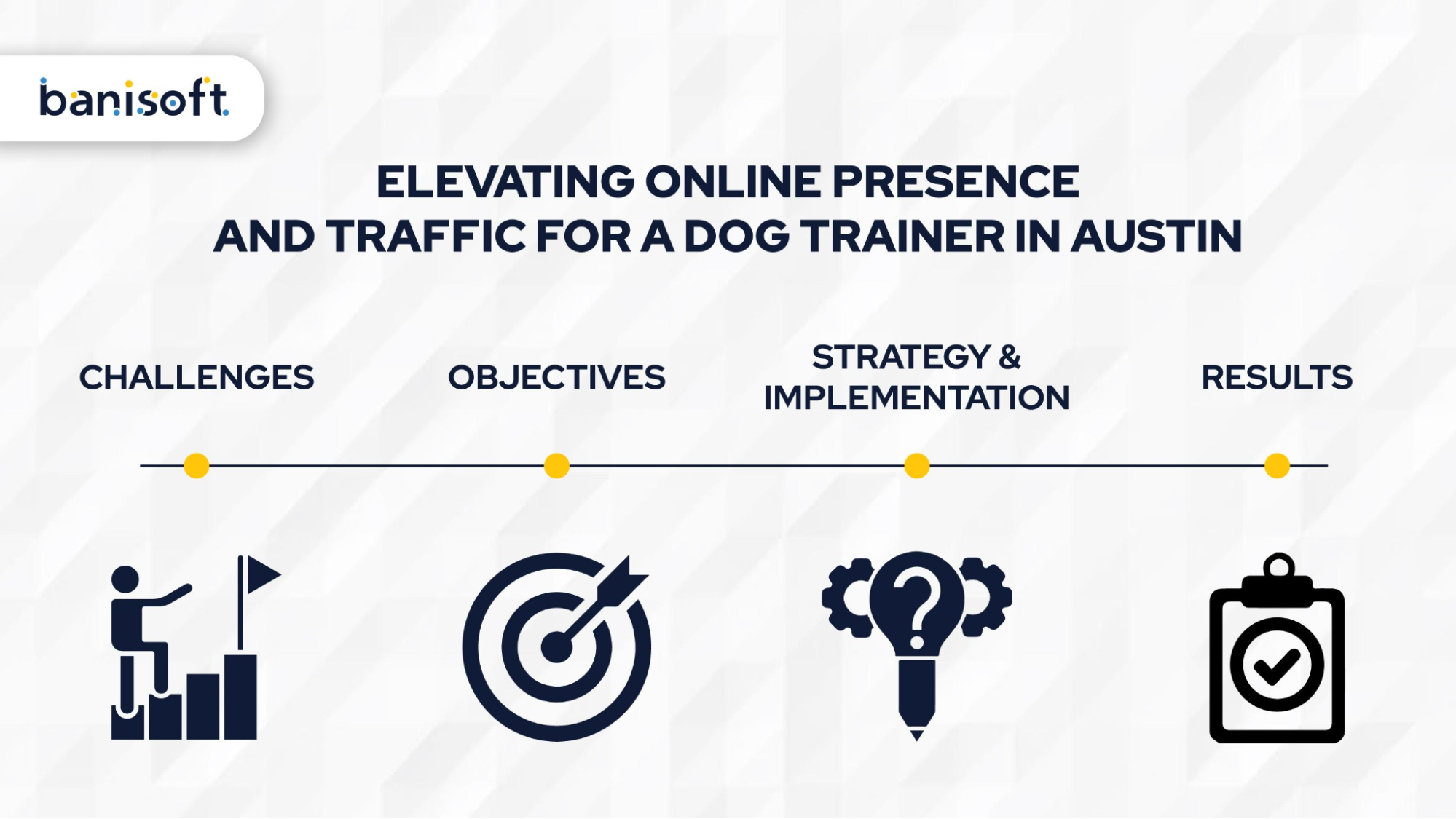
Client: Austin Dog Trainer
Agency: Banisoft – High Conversion-Centric SEO Services
Introduction
Our client, an experienced dog trainer in Austin, had difficulty attracting new clients despite their excellent services.
They turned to Banisoft for help boosting their online visibility and website traffic.
Within just three months, our local SEO strategies led to a 50% increase in their website traffic. This case study outlines our steps and offers tips for similar businesses looking to enhance their online presence.
Challenges
- Low online visibility
- Poor local search engine rankings
- Limited client engagement and reviews
- Inconsistent website traffic
Objectives
- Increase website traffic by 50% within three months
- Improve search engine rankings for local keywords
- Optimize Google Business Profile
- Boost client engagement through reviews
Strategy and Implementation
- Google Business Profile Optimization
- Complete Profile: We ensured the client’s Google Business Profile was fully optimized with detailed information.
- Photos and Videos: Added high-quality images and videos of training sessions and facilities to attract potential clients.
- Regular Updates: Posted updates about events, promotions, and training tips to keep the profile active.
- Keyword Research and Optimization
- Geo-Targeted Keywords: Identified high-traffic, low-competition keywords like “dog trainer in Austin” and “Austin puppy training.”
- Content Optimization: Enhanced website content with these keywords and created new blog posts to target local queries.
- Encouraging Client Reviews
- Review Requests: Sent personalized follow-up emails and SMS to clients, asking for reviews.
- Incentives: Offered discounts or free training materials for leaving reviews.
- Local SEO Enhancements
- Local Citations: Listed the business on local directories to boost SEO.
- Backlinks: Acquired high-quality backlinks from local websites.
- Mobile Optimization: Ensured the website was mobile-friendly, improving loading speed and usability.
Results
- Traffic Increase: Achieved a 50% increase in website traffic within three months.
- Improved Rankings: Secured first-page rankings for keywords like “dog trainer in Austin.”
- Client Engagement: Increased positive Google reviews by 75%, enhancing online reputation.
- Conversions: Saw a 40% rise in inquiries and bookings.
Conclusion
By implementing a targeted local SEO strategy, Banisoft helped an Austin dog trainer significantly boost their online presence and attract more clients.
This case study illustrates the impact of local SEO and how Banisoft’s services can drive growth for small businesses.
Connect With Us Today
Are you a dog trainer looking to boost your online presence and attract more clients?
Contact Banisoft today for a free consultation and let our experts craft a customized SEO strategy that works for you!
Top SEO Strategies to Boost Your Dog Training Business Read More »



